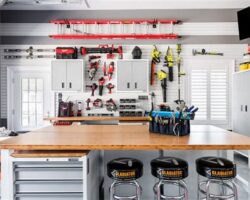Are you tired of rummaging through a cluttered and disorganized workshop every time you need a specific tool or material? If so, a DIY workshop with the right tools and efficient storage solutions could be just what you need to streamline your projects and enhance productivity. In this blog post, we’ll explore the benefits of setting up your own workshop, the importance of choosing the right tools and designing an efficient layout, and building essential storage solutions. Whether you’re a seasoned DIY enthusiast or just starting out, this guide will provide valuable insights into creating a well-organized and safe workspace. From versatile workbenches to organizing tools and supplies for easy access, we’ll cover all the essential aspects of setting up a functional DIY workshop. So, roll up your sleeves and get ready to transform your workspace into a productive and safe environment for all your DIY projects.
Benefits of DIY Workshops
DIY workshops offer many benefits for individuals who enjoy working with their hands and creating things on their own. One of the main advantages is the sense of satisfaction and accomplishment that comes from completing a project from start to finish. Whether it’s building a piece of furniture, crafting a new decoration for the home, or fixing something that’s broken, there’s a great feeling of pride that comes with knowing you did it yourself.
Another benefit of DIY workshops is the opportunity to learn new skills and expand your knowledge base. By taking on different projects and tackling various challenges, you can develop a range of abilities that will serve you well in many areas of your life. From woodworking and metalworking to sewing and painting, there’s always something new to learn and master.
DIY workshops also provide a way to save money on home improvement and repair projects. Instead of hiring a professional to do the work for you, you can invest in some essential tools and materials and take care of things yourself. This not only cuts down on expenses but also gives you the freedom to customize and personalize your creations exactly how you want them.
Lastly, engaging in DIY workshops is a fantastic stress-reliever and can help you unwind and relax after a long day. The act of working with your hands and focusing on a specific task can be a form of meditation and is a great way to take your mind off of everyday worries and concerns. Whether you’re hammering, painting, or stitching, the act of creating something with your own hands can be incredibly therapeutic and fulfilling.
Choosing the Right Tools for Your Workshop
When setting up your workshop, it’s crucial to choose the right tools for the job. Whether you’re a seasoned DIY enthusiast or just starting out, having the right tools will make your projects more efficient and enjoyable.
One of the most important aspects of choosing the right tools for your workshop is considering the type of projects you’ll be working on. If you’re primarily going to be woodworking, for example, you’ll need a different set of tools compared to someone who focuses on metalworking.
Another factor to consider is the quality of the tools. While it may be tempting to go for the cheapest option, investing in high-quality tools will pay off in the long run. They’ll be more durable, perform better, and ultimately save you time and money.
Lastly, it’s important to think about the ergonomics of the tools. Comfortable, well-designed tools will reduce the risk of injury and make your work more enjoyable. Ergonomics is especially important if you plan on spending long hours in your workshop.
Designing an Efficient Workshop Layout
When designing an efficient workshop layout, it’s important to consider the workflow and functionality of the space. A well-designed workshop can improve productivity and make tasks easier to complete.
One key element to consider is the space available. Ensure that there is enough room for tools, equipment, and materials, as well as sufficient space for movement and working comfortably.
Another important aspect is organization. Utilize storage solutions such as cabinets, shelves, and tool racks to keep everything in its place. This not only makes it easier to find tools and materials but also enhances safety by reducing clutter.
Additionally, consider the layout of the workshop. Place frequently used tools and equipment in easily accessible areas, while keeping less frequently used items in storage areas. This can help streamline the workflow and minimize unnecessary movements.
Building a Versatile Workbench
When undertaking any DIY project, having a solid workbench is essential. A versatile workbench is a valuable addition to any workshop, allowing you to work on a variety of projects with ease. Whether you’re a seasoned woodworker or just starting out, having a reliable surface to work on can make all the difference.
Building your own workbench allows you to customize it to suit your specific needs. You can choose the materials that best fit your budget and the size that fits your available space. This level of customization ensures that your workbench will be the perfect fit for your workshop.
When designing your workbench, consider including features that will enhance its versatility. Adding storage shelves, drawers, and tool racks can help keep your work area organized and free from clutter. This will enable you to work more efficiently and safely, as you’ll be able to easily access the tools and materials you need for each project.
Additionally, make sure to use durable, high-quality hardware such as screws, bolts, and brackets to ensure that your workbench is strong and sturdy. Taking the time to build a workbench that is well-constructed and durable will pay off in the long run, as it will provide a reliable surface for all of your DIY projects.
DIY Storage Solutions for Tools and Materials
Whether you are a professional craftsman or a casual DIY enthusiast, having an organized and efficient storage solution for your tools and materials is essential. Not only does it make it easier to find and access what you need, but it also helps to prolong the life of your tools and keeps your workspace clutter-free.
One DIY storage solution is to build a custom pegboard wall in your workshop. This allows you to hang your most frequently used tools within easy reach, keeping them organized and easily accessible. You can also customize the layout to accommodate specific tools and make use of small baskets or shelves to hold smaller items.
Another great DIY storage option is to build a rolling tool cart or cabinet. This provides a mobile storage solution that can be moved around your workshop as needed. You can design the cart to have drawers, shelves, and compartments to keep all of your tools organized and within arm’s reach while you work on different projects.
Furthermore, utilizing wall-mounted shelves, stackable bins, and tool racks are also effective DIY storage solutions for keeping your workshop tidy and efficient. By implementing these storage solutions, you can make the most of your space and ensure that your tools and materials are always well-organized and easy to access.
Organizing Tools and Supplies for Easy Access
Organizing your tools and supplies in your workshop can make a world of difference when it comes to efficiency and convenience. It is important to label and categorize all of your tools and materials so that you can easily locate them when needed. By implementing a system for organization, you can save time and reduce the frustration of searching for specific items.
One effective way to organize your tools and supplies is to invest in a tool cabinet or pegboard. These storage solutions allow you to hang and store your tools in a way that keeps them visible and easily accessible. You can also use bins, drawers, and shelves to keep your supplies organized and within reach.
Another important aspect of organizing for easy access is to keep your work area clean and clutter-free. By regularly tidying up and putting tools back in their designated spots, you can maintain a productive and efficient workspace. This also helps to prevent accidents and injuries that can occur when tools and materials are strewn about.
Lastly, consider using color-coded labels or markings to distinguish different categories of tools and supplies. This visual cue can make it even easier to find what you need in a hurry, saving you time and streamlining your workflow.
Safety Measures and Storage Solutions for Hazardous Materials
When working in a workshop, it’s important to prioritize safety measures to prevent accidents and protect yourself from hazardous materials
One essential safety measure is the use of personal protective equipment (PPE), such as gloves, goggles, and respirators, when handling hazardous materials. It’s vital to ensure that PPE is in good condition and properly fitted to provide maximum protection.
To prevent fires and explosions, it’s important to store hazardous materials in dedicated cabinets or containers. These storage solutions should be labeled and organized to ensure easy access and prevent cross-contamination.
Implementing proper ventilation systems in the workshop is also crucial to minimize exposure to hazardous fumes and chemicals. This can include exhaust fans, air purifiers, and fume hoods to effectively remove contaminants from the air.





